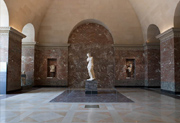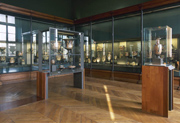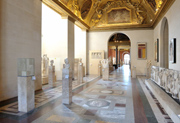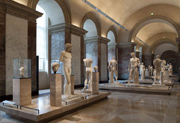|
|

The Department of Greek, Etruscan, and Roman Antiquities is home to a collection of artworks representing the Greek, Etruscan, and Roman civilizations; it illustrates the art of a vast area encompassing Greece, Italy, and the whole of the Mediterranean basin, and spans the period from Neolithic times (4th millennium BC) to the 6th century AD.  Antiquités grecques, étrusques et romaines, salle 16 : Vénus de Milo © 2010 Musée du Louvre / Angèle Dequier The construction of the collection
The antiquities department (which opened in 1793) was formed around the former royal collections, enriched by property seized during the French Revolution. In 1800, the museum was installed in Anne of Austria’s summer apartments; in 1807, the purchase of over five hundred marble sculptures from the Borghese collection required the refurbishment of the Salle des Cariatides, the ground floor of the Pavillon du Roi, and the queen’s winter apartments. After the return of the works to Italy in 1815, Ennio Quirino Visconti (1751-1818), the Louvre’s first curator of antiquities, adopted an active acquisitions policy. The Venus de Milo (presented to Louis XVIII by the Marquis de Rivière) entered the museum in 1821.
The Louvre’s collection, mostly comprised of marble sculptures, was enriched with archaeological objects when the Tochon collection was purchased in 1818, followed by that of Durand (1825-1836); this led to the opening of the Musée Charles X on the first floor of the Louvre palace in 1827. When the Campana collection was acquired in 1861, its vases were installed on the first floor of the Cour Carrée’s south wing, in a gallery parallel to the Musée Charles X.
 Antiquités grecques, étrusques et romaines, galerie Campana © 2002 Musée du Louvre / Pierre Ballif The museum acquired many objects from North Africa and the Ottoman Empire during the second half of the 19th century, as a result of archaeological expeditions. The Victory of Samothrace (discovered by Champoiseau in 1863) was placed at the top of the Daru staircase in 1884. Ancient Greek sculpture then came to the fore with the Kore of Samos, the Rampin Head, the Lady of Auxerre, and the Tanagra figurines of Boeotia. In the early 20th century, it was decided to renovate the department completely, and this project was carried out in various stages: in 1934, the museum of sculpture inaugurated by Napoleon was dismantled,and chronological classification was established; a section devoted to Greek art—centered on the sculptures in the queen’s winter apartments, the Salle de Diane, and the Salle des Cariatides—opened on the ground floor; and a Roman art section was created around the former summer apartments of Anne of Austria. The first floor was reorganized in the postwar period: bronzes were displayed in the Salle Lacaze, Etruscan art in the Salle Henri II, and Roman silverware and frescoes in the Salle des Bijoux.
 Antiquités grecques, étrusques et romaines, salle 22 : antiquités romaines © 2009 Musée du Louvre / Stéphane Olivier Organization of the department
The present arrangement of the department is the result of an ambitious reorganization plan initiated in 1980, when the Etruscan collections were displayed on the ground floor (between the Cour du Sphinx and the Petite Galerie), and Roman sculptures moved to the Petite Galerie and the Salle d'Auguste. In the 1990s, after the inauguration of the Louvre pyramid, a new organizational project was launched, initially concerning the Greek art collection and the first-floor rooms (1997-2010). The Preclassical Greek gallery opened in 1997, supplemented by a gallery dedicated to Greek epigraphy, a room representing the Severe style, and a new room (under the Winged Victory staircase) devoted to the Temple of Zeus at Olympia; a new entrance to the department was created as a result, combining artworks representing a wide range of materials and techniques. The same year saw other changes, with the renovation of the Galerie Daru, and the refurbishment of the first floor: silverware was moved to the Salle Henri II, glassware to the former jewelry room, terracotta figurines and reliefs took over half the former Musée Charles X, and the bronze room and Galerie Campana were fully renovated. The Salle du Manège opened in 2004, and in 2006 the Salle de Diane was rearranged to display the Parthenon marbles. The renovation of the Greek art section was finalized in July 2010 with the opening of rooms dedicated to classical Greek and Hellenistic art, and a new home for the Venus de Milo on the ground floor of the Pavillon du Roi. In all,the section comprises ten rooms that form two galleries in the former royal apartments, supplemented by the famous Salle des Cariatides; the chronological display of ancient Greek art initiated in 1997 is thus complete. In the years to come (2013-2016), the department plans to reorganize the rooms devoted to Roman art around the Cour du Sphinx, and to create a new first-floor display devoted to Italic and Etruscan art, by annexing the Salle des Sept Cheminées (formerly the King’s chamber, above the Venus de Milo room).
 Antiquités grecques, étrusques et romaines, salle 14 : Grèce classique © 2010 Musée du Louvre / Angèle Dequier |
||